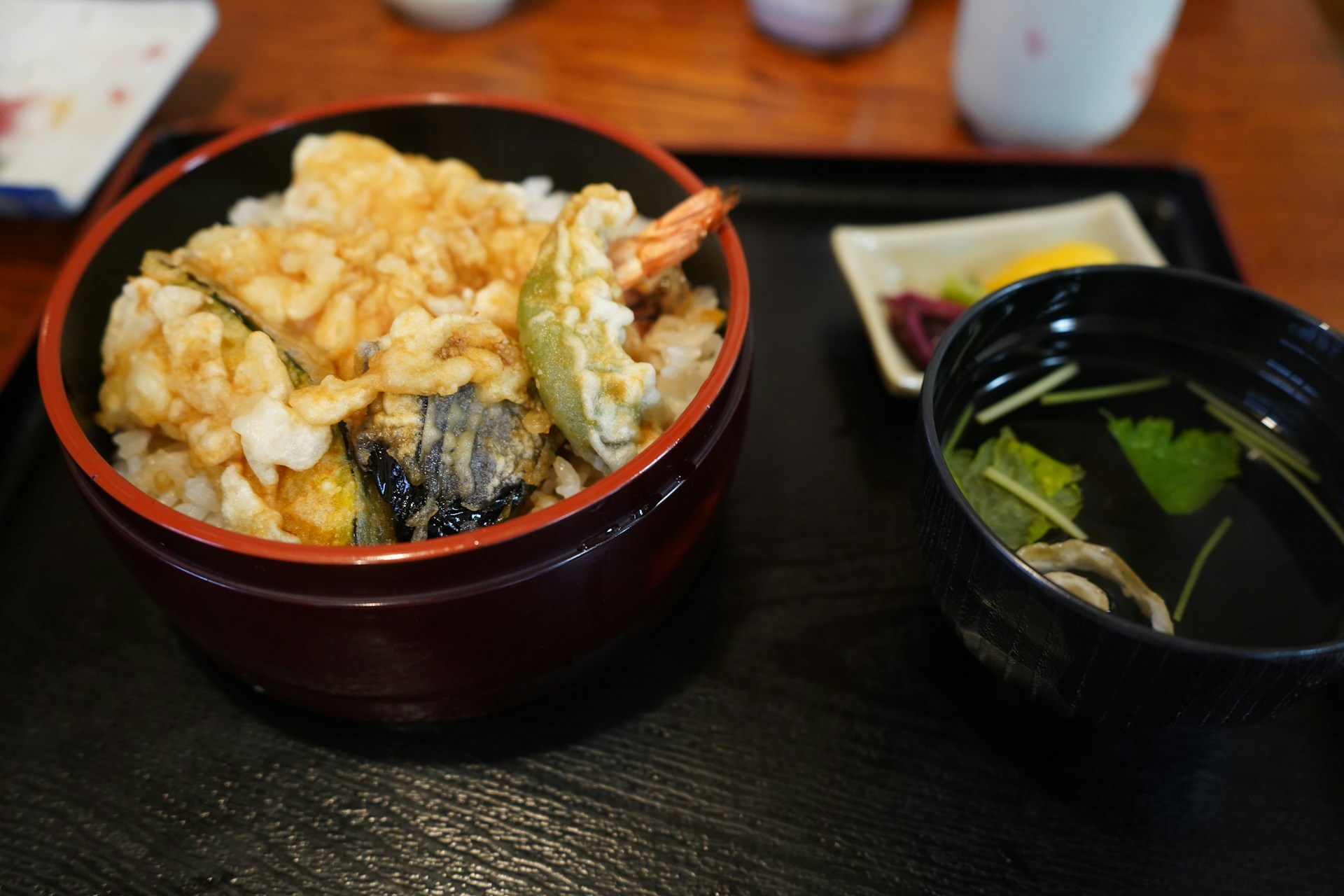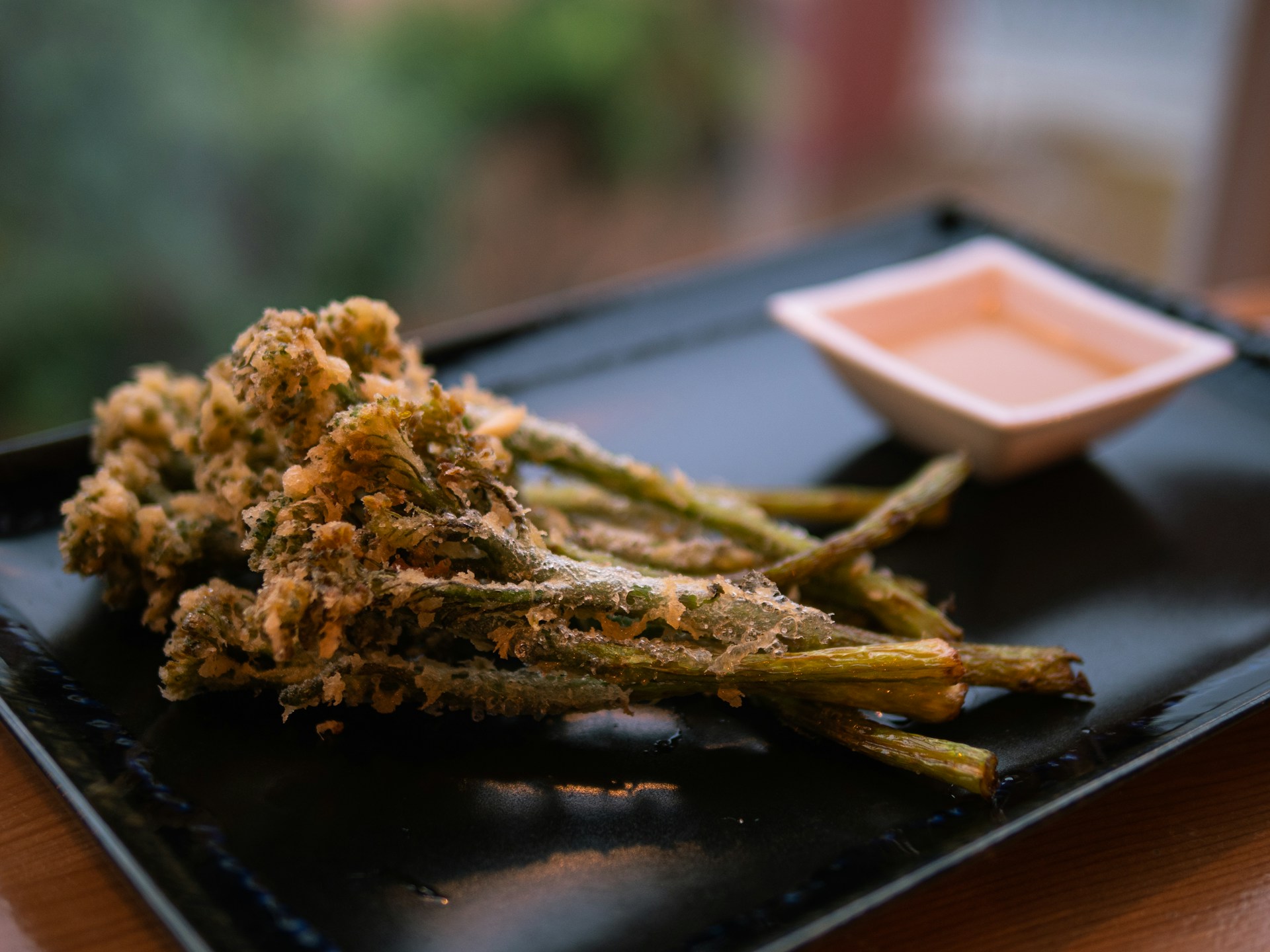The Japanese culinary art form of tempura is a tribute to the power of batter and hot oil, turning ordinary items into ethereal, crispy treats. Scooping up the classic crispy, light texture is like trying to catch a food cloud. It’s a taste that’s satisfying and delicate at the same time—a difficult balance to achieve. It makes sense that years pass before a single deep-fat fryer is ever switched on for Japanese experts of tempura.
Seven Steps To Excellence
The following are the 7 secrets to an incredibly light and perfectly crispy tempura batter, without intending to diminish the dedication to such research.
1. Your Tempura battery’s temperature is crucial.
The temperature of your batter holds the first secret. The tempura batter needs to be chilly; picture the chilly whisper of a winter wind contrasting with the summer heat of the frying oil. This is because the wheat’s gluten does not develop to an excessive degree in the cold, which would otherwise give the flour a dense, doughy texture.
Make use of icy water, and you could even want to chill the flour beforehand. The desired light, crisp coating is produced instantly when the shock of cold batter encountering hot oil forms a steam barrier.

2. Give My Flours To Me
Selecting the proper flour is essential. Although all-purpose flour works just fine, using soft wheat flours like cake or even rice flour will result in a lighter texture. Less protein in these flours results in less gluten production and a softer bite.
Look for speciality tempura flour at “Asian” stores, which frequently have added starch to produce an extra crispy finish, for an authentic touch—or, you know, a little shortcut. The “tempura mix,” also known as Asian supermarket tempura flour, is a carefully blended ingredient that produces the distinctively crispy and light exterior of conventional tempura.
Low-protein wheat flour, cornflour or tapioca starch for crunch, leavening agents (baking soda or powder) for lift, and a dash of salt for taste are usually included in this handy blend.
In addition to additional flavour enhancers and seasonings, certain products could also contain egg powder for binding and colour, MSG to improve umami, and other ingredients. Depending on the brand’s recipe, the mix simplifies the tempura-making procedure, requiring only the addition of cold water and possibly an egg.
3. Stations for Carbonation
The majority of seasoned tempura cooks swear by the secret of adding carbonated water. The water bubbles cause little air pockets to form in the batter, which adds to the finished product’s lightness. Choose club soda or sparkling water, and before adding it to your batter, make sure it’s as cold as the Arctic tundra.

4. A Simplified Combination
In the tempura world, overworking the batter is a sin. The components should be barely combined. Not only are a few lumps okay, they’re preferred. They add to the batter’s irregularity, which results in a texture that is more intriguing. Blend using a fork or chopsticks until the ingredients are just combined, with the careful care of a butterfly’s wingbeat.
5. Accurate Oil Temperature
The temperature of the frying oil is the key factor that needs to be considered now. Here’s the trick that will either make or shatter your tempura. Not just any heat will do; the oil needs to be heated exactly right. A temperature of 170°C to 180°C is the ideal range. If it’s too low, the tempura will become oily and heavy as it absorbs oil like a sponge. Elevate the temperature too much, and it will sear to a harsh crunch before the interior begins to cook.
Consequently, infrared thermometers are frequently used in professional kitchens to continuously check the temperature of the oil. It is advisable that you follow suit. Precisely cooked within with a golden, airy exterior is the product of quick, even cooking at the proper temperature.
6. The Dipping Dance
Use caution when gently dipping your ingredients into the batter. Instead of completely submerging your ingredients, simply coat them and let any excess drop off. By doing this, the batter is kept from getting overly thick, which would make the tempura lose its characteristic lightness.
7. The Real Fry
Lastly, one must approach the actual act of frying with a combination of patience and attention. Avoid packing the pan too full since this will cause the oil’s temperature to drop and cause the temperature to become soggy.
Small batches should be fried, and the pieces should be moved gently in the oil to achieve equal cooking and avoid sticking. They can be saved onto a wire rack or paper towels to drain any extra oil after they turn a pale golden colour and float to the top.
Let’s talk about the pan itself: while some people would prefer to utilise an air fryer, there are specific tempura pans that are the greatest for frying. usually made with broad openings and straight sides to facilitate easy flipping of the tempura pieces and to assist in maintaining a constant temperature in the oil for proper cooking. Additionally, they frequently have an integrated drain rack to remove extra oil, keeping the tempura crispy and light.
The Perfect Recipe for Tempura Batter
Making the ideal tempura batter is like making a work of art. It’s straightforward but profound, requiring dexterity and a hint of artistic flair.
This recipe will consistently yield a crispy, light coating, and it also includes a list of things that work well for wrapping in the golden shroud.

Components:
- One cup (120g) of tempura or cake flour (use rice flour if gluten-free)
- One cup (240 ml) of sparkling water or club soda, or ice-cold carbonated water
- One big, chilly egg yolk
- A small amount of salt
- Frying vegetable oil (like peanut or canola oil)
Guidelines:
- Assemble the Ingredients: Make sure all of your ingredients are chilled before starting. While the carbonated water is in the freezer for a little while (do not allow it freeze!), chill the flour in the refrigerator.
- To combine the ingredients, lightly beat the egg yolk in a big bowl until it’s slightly broken up. Gently whisk in the ice-cold carbonated water after adding it to the egg yolk. Sift the salt and flour right into the mixture. Make quick strokes to combine the ingredients with a fork or chopsticks. Recall that lumps are necessary and acceptable. Just enough batter should be stirred to moisten the flour; avoid overmixing.
- Heat the Oil: Pour at least two inches of vegetable oil into a deep, heavy-bottomed pot or deep fryer. Bring the oil’s temperature up to 170–180 degrees Celsius. To make sure the temperature is precise and constant, use a kitchen thermometer.
- Chop your selected ingredients (more on that later) into bite-sized pieces in order to prepare them for frying while the oil is heating. To make sure the batter adheres correctly, pat them dry with paper towels.
- Batter and Fry: After the oil reaches the proper temperature, dip each component into the batter separately, letting the extra batter drop to the bottom. Drop them into the boiling oil with caution. To maintain the oil’s temperature, work in batches rather than packing the pot too full. Fry for two to three minutes, or until the batter turns a light golden colour and the components come to the surface.
- Drain: To get rid of extra oil, take the tempura out of the oil with a slotted spoon or tongs and place it on a wire rack placed over a baking sheet or paper towels.
- Serve immediately since tempura tastes best when it’s hot and fresh. Present the dish with a choice of accompaniments, such tentsuyu, which is a blend of soy sauce, mirin, and dashi, or a light dusting of sea salt.
Suggested Battering Ingredients
- Veggies
- Sweet potato, cut thinly
- cauliflower or broccoli florets
- Trimmed asparagus
- sliced stems off shiitake mushrooms
- Slabbed pumpkin into thin slices
- Sliced aubergine into somewhat thin pucks
- carrot, thinly sliced or split into matchsticks
- Green beans with cut ends
Seafood
- Peel and leave the tails on prawns
- Squid, sliced into strips or rings
- Bite-sized portions of white fish fillets
- Muscle taken from scallops
Appetisers for Tempura
The sides are crucial in elevating the whole experience when it comes to balancing the delicate crispness of the tempura. The umami-rich tentsuyu dipping sauce, which is a wonderful balance to the batter’s lightness, is a favourite among traditionalists. It is a harmonic blend of dashi broth, mirin, and soy sauce. Add some grated daikon radish and a squeeze of fresh lemon juice to the tentsuyu for a tangy twist.
If you like your seasoning dry, try adding a dash of flavoured sea salts. To add a little of earthiness, try matcha salt, yuzu salt, or even a smokey chilli salt for a hint of citrus and warmth. Different nuances in the tempura can be brought out by different salts.
Serving tempura alongside tsuyu sauce that has been thickened with grated daikon is another well-liked alternative. The thick dipsticks to the tempura and creates a contrast in textures. A spicy mayo or aioli can make a tasty companion for a more contemporary take, offering a creamy counterpoint to the crunch.
Finally, remember the power of simplicity: for those who value the subtle refinement of tempura’s flavour, a little bowl of excellent soy sauce can make the ideal dip. Whatever you decide, make sure it enhances the delicate flavour of the tempura rather than overpowers it.
The Final Word
Understanding the subtle interactions between hot and cold, light and crisp, is essential to mastering the art of tempura. It’s about timing and discipline, about knowing when to be firm and when to be soft.
You can now make tempura that is as crisp as a new autumn morning and as light as air thanks to these seven culinary techniques. Thus, preheat your oil, cool your batter, and set out to get the ultimate tempura experience. Good appetite, or “Itadakimasu” as the Japanese would say!









 in London.
in London.